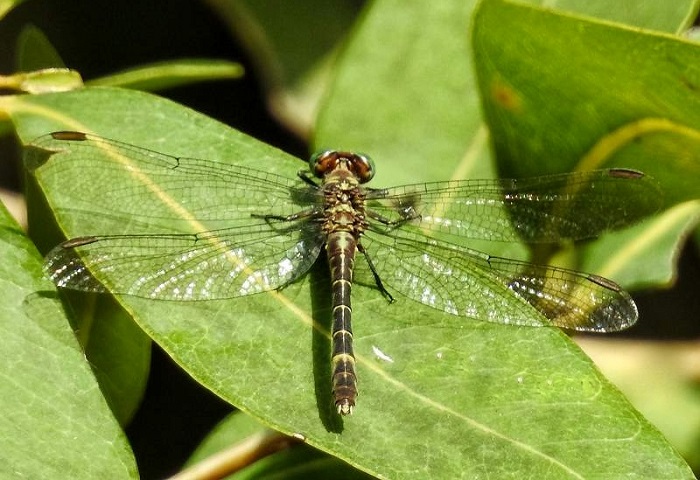Cover photo by John Wilkinson.
Find the Eastern Scissortail in the FBIS database (Freshwater Biodiversity Information System) here.
Family Gomphidae
Identification

Swadini, Blyde River, Mpumalanga
Photo by Antoinette Snyman
Inset image by Andries DeVries
Medium sized
Length reaches 43mm.
The Eastern Scissortail is the smallest gomphid species in Southern Africa. It is best recognised by its small size and distinctive claspers. Microgomphus nyassicus has the typical yellowish-green and black colouration of many gomphid species. It also has unusual, thick black, looped markings on the upper thorax.
Within the sub-region, the Eastern Scissortail is most similar to the Spined Fairytail (Lestinogomphus angustus). Both species are close in terms of size and colouration, but the Spined Fairytail has a far more slender abdomen and the two have very different clasper structures.
Click here for more details on identification of the Eastern Scissortail.

Swadini, Blyde River, Mpumalanga
Photo by Antoinette Snyman
Habitat
The Eastern Scissortail is recorded from rocky rivers and streams in well-wooded or forested environments. It favours flowing water with large rocks and nearby cover in the form of shady vegetation and reeds.

Photo by Andries DeVries
Behaviour
The Eastern Scissortail is highly elusive and easily overlooked. Interestingly larvae, exuvia, and adult females are found more often than adult males. The males appear to spend much of their time in the shade of bushes and trees some meters from the river. They are seemingly active for only a short period during the hottest time of the day, when they sit on sunny boulders and reeds close to the water. Females are found among trees and bushes not too far from the river. Despite its elusiveness, the Eastern Scissortail is fairly tame and confiding.

Swadini, Blyde River, Mpumalanga
Photo by Antoinette Snyman
Status and Conservation
Very little is known about the Eastern Scissortail. The paucity of records from throughout its range suggests Microgomphus nyassicus is rare, but more data is needed. It is currently listed as of Least Concern in the IUCN Red List of Threatened Species.
An exuvia, believed to belong to this species was found at Oribi Gorge, KwaZulu-Natal in 1988. Another was found near the Komati River, Mpumalanga in 2018.
The first record of an adult in South Africa, was by Antoinette Snyman on the Blyde River, Mpumalanga in May 2019. See the identification image above.

Swadini, Blyde River, Mpumalanga
Photo by Andries de Vries
Distribution
The Eastern Scissortail is erratically distributed in South-East Africa. It has been recorded from Southern DRC, Northern Zambia, and Malawi as well as the border region between Zimbabwe and Mozambique and a few scattered locations in South Africa.
In South Africa, it has been recorded from the Mpumalanga and KwaZulu-Natal provinces.
There are no maps for this species at present.

Swadini, Blyde River, Mpumalanga
Photo by John Wilkinson
Further Resources
The use of photographs by Andries de Vries, Antoinette Snyman, and John Wilkinson is acknowledged.
Eastern Scissortail Microgomphus nyassicus (Grünberg, 1902)
Other common names: Oostelike Knipstertjie (Afrikaans)
Recommended citation format: Loftie-Eaton M; Navarro R; Tippett RM; Underhill L. 2025. Eastern Scissortail Microgomphus nyassicus. Biodiversity and Development Institute. Available online at https://thebdi.org/2020/08/24/eastern-scissortail-microgomphus-nyassicus/
References: Tarboton, M; Tarboton, W. (2019). A Guide to the Dragonflies & Damselflies of South Africa. Struik Nature.
Samways, MJ. (2008). Dragonflies and Damselflies of South Africa. Pensoft
Samways, MJ. (2016). Manual of Freshwater Assessment for South Africa: Dragonfly Biotic Index.Suricata 2. South African National Biodiversity Institute, Pretoria

